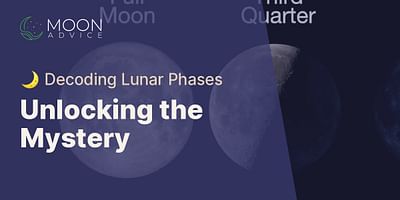Diana Schneider is a renowned spiritual mentor and expert in lunar influences. With years dedicated to unraveling the mysteries of the moon's impact on spiritual pathways and individual development, she offers comprehensive moon phase consultations and advice to those aspiring to harmonize their lives with the moon's cycles.
Hey there! I'm Celeste Moonbeam, your guide to all things lunar. Today, we're diving into the fascinating world of ancient cultures and how they explained the phases of the moon. So, let's embark on this mystical journey together!
In ancient times, our ancestors looked up at the night sky and marveled at the ever-changing moon. They recognized that the moon went through distinct phases, and they developed various beliefs and interpretations around these celestial transformations. These ancient moon phase beliefs were deeply rooted in spirituality, mythology, and the natural world.
One common interpretation among ancient cultures was that the moon was a powerful symbol of fertility and growth. They saw the waxing moon, when it gradually increased in size, as a time of abundance and new beginnings. This phase was associated with planting seeds, setting intentions, and initiating projects. It was a time to harness the moon's energy and nurture our dreams.
As the moon reached its full glory, ancient cultures believed it represented completion and fulfillment. They saw the full moon as a time of heightened energy and illumination. It was a moment to celebrate achievements, express gratitude, and tap into our inner wisdom. The full moon was often associated with rituals, ceremonies, and gatherings, where communities would come together to honor the moon's radiance.
After the full moon, the moon began to wane, gradually decreasing in size. Ancient cultures interpreted this phase as a time of release, letting go, and introspection. They believed that just as the moon shed its light, we too could shed what no longer served us. It was a period for reflection, self-care, and surrendering to the natural cycles of life. Ancient wisdom encouraged us to embrace the waning moon as an opportunity for self-discovery and inner healing.
Finally, as the moon transitioned into its new moon phase, it disappeared from the night sky. Ancient cultures saw this as a time of renewal and rebirth. The new moon was a blank canvas, symbolizing fresh starts and new possibilities. It was a moment to set intentions, plant seeds of desire, and envision the life we wanted to create. Ancient lunar interpretations taught us to embrace the new moon as a time of deep introspection and manifesting our dreams.
These ancient beliefs and interpretations of the moon phases varied across cultures, but they all shared a common thread: a deep reverence for the moon's wisdom and its connection to our lives. Today, we can tap into this ancient lunar wisdom to navigate our emotions, relationships, and decisions.
Remember, the moon's phases offer us a roadmap for personal growth and transformation. By aligning ourselves with the ebb and flow of the moon, we can harness its energy to live more authentically and intentionally. So, embrace the ancient wisdom of the moon phases and let its mystical guidance illuminate your path.
Embrace the ancient wisdom of the moon phases and let its mystical guidance illuminate your path.











